For antique and vintage clock repair having a selection of quality tools is absolutely essential.
As an avid enthusiast and a keen learner over the past 7 years, I have been steadily building my knowledge of clock repair and with it a selection of essential clock tools.
Disclaimer. While not a trained horologist I have some advanced skills-sets but I am still learning as I go
Part I of this two-part series describes the basic tools for those just starting out. The tools/equipment described here are for the more advanced hobbyist/amateur horologist.
Some folks bush by hand and I applaud them for their patience and skill. I chose a bushing machine
Ultrasonic Cleaner: This Harbor Freight special will do for now but it is so low powered that a newer, more powerful machine is on the horizon. It does not perform as well as better quality machines and it has a limited load capacity. An eight minute limit for each cycle means that several cycles are required to properly clean clock parts. It is a start.
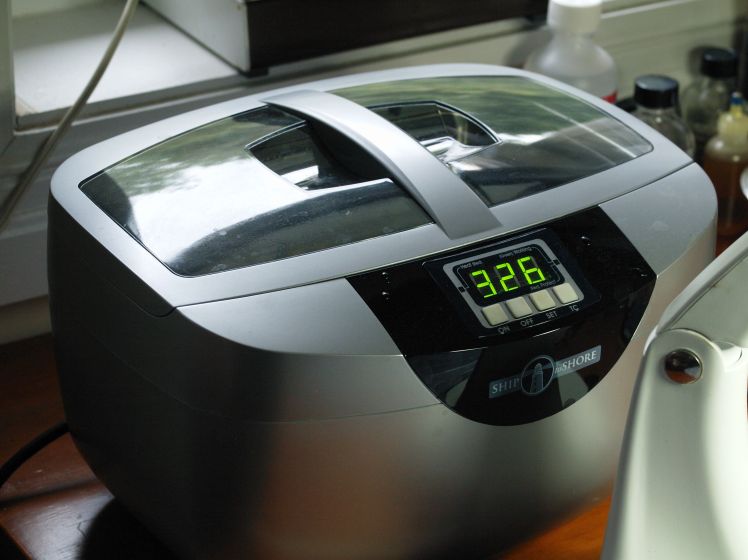
Spring winder: An essential tool. Disassembling clock movement also includes servicing the mainsprings. Mainsprings must be inspected for breaks, cracks and splits, cleaned of old oil and rust (as long as there is not too much rust) and lubricated prior to re-installing them into the movement. Too much rust and they should be discarded. I generally do not replace springs in a movement unless they are quite set, or have breaks or cracks. I have found that the steel in the original movement is better quality than can be found today. Mounting the spring winder on a piece of hardwood provides a stable tool and allows it to be clamped to a work-desk.
Although there are other types of spring winders, the Olie Baker winder is one of the better choices in my view. It is well made and should last for years. If you can find a used one you will save a little.
Joe Collins has plans for a homemade spring winder that you can find on the National Association of Watch and Clock Collectors site.

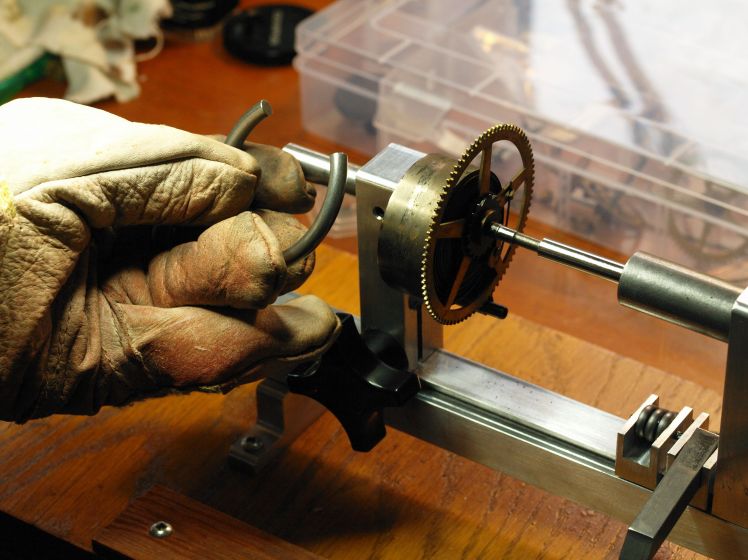
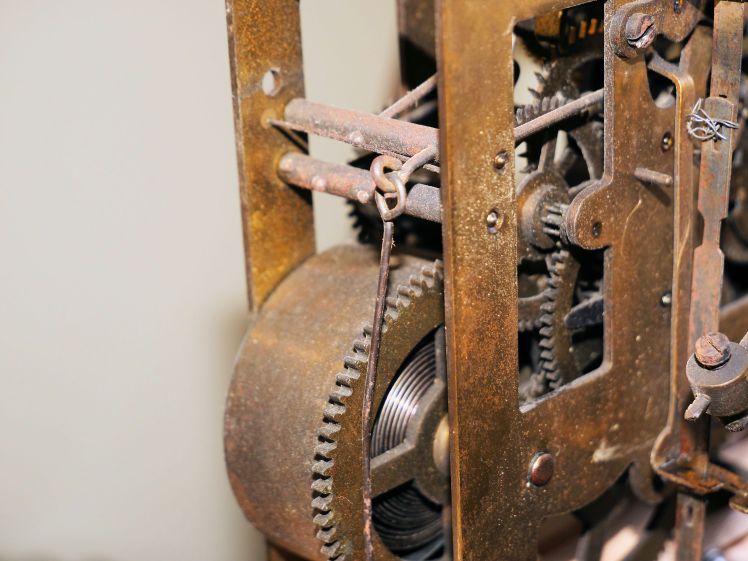
Bergeon 6200 Bushing Machine: Some bush by hand and they are to be applauded for their patience and skill. I chose a bushing machine for the delicate work of installing bushings. This is the Bergeon 6200 which is made in Switzerland. It is exceptionally well made and relatively simple to use.

The machine can be bought separately or with a set of cutters and other hardware (above). The cutters can last 15 years or more. Of course, you must also have an assortment of correctly sized brass bushings that are purchased separately from any clock supply house.
To operate, a correct size cutter is placed in the bottom end of the steel shaft, holes are cut after which the new bushings are punched in place with a hammer head fitted to the shaft.

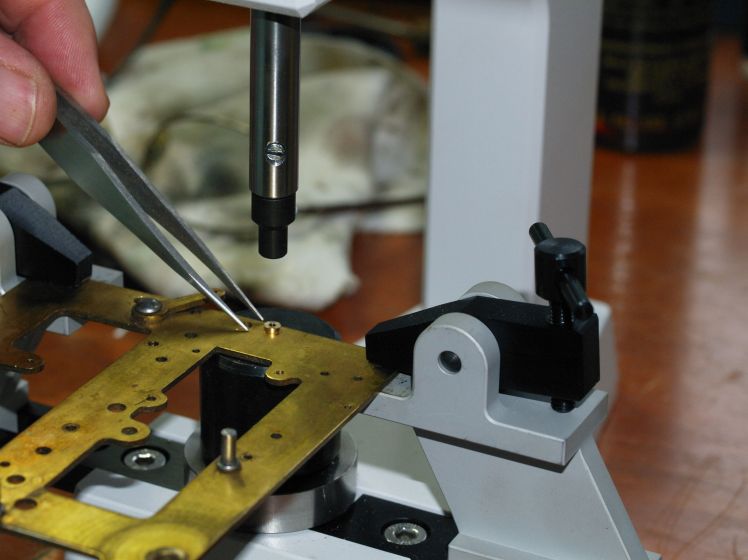
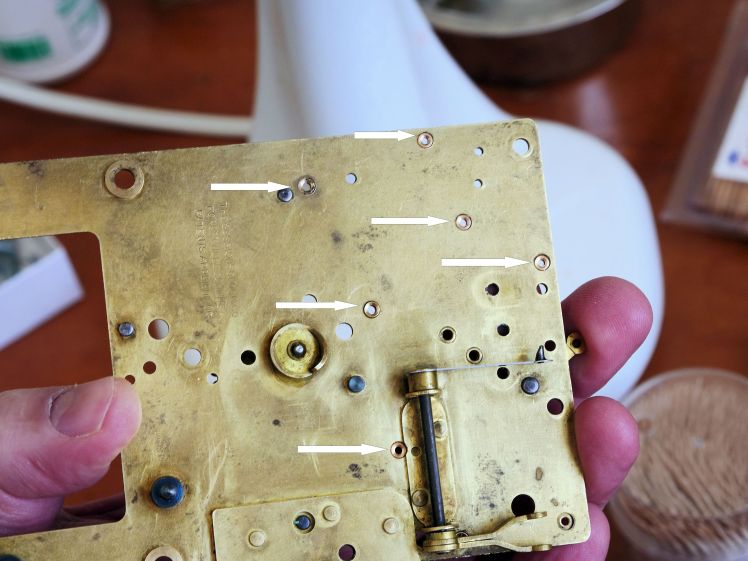
Clock repair is not as expensive as some might think especially when you spread your costs over months or years
Lathe: Good quality mini lathe are available from Sherline, Taig and others. A cost effective option is the Taig Miniature Lathe for metal. The Taig lathe was originally designed for precision machining of watch and clock parts; ideal for clock repair applications. The small office space in my home means that its compactness, portability and relative simplicity are attractive features.

Reference/Reading material: I recommend the Steven Conover series of repair manuals. The manuals are well written, detailed and are great resources for the beginner or the advanced amateur.
- Steven G. Conover; Clock Repair Basics
- Steven G. Conover; Striking Clock Repair Guide
- Steven G. Conover; Chime Clock Repair
The purchase of clock supplies and equipment has become my personal journey. First, I acquired some basic clock repair tools when I began taking movements apart, then learned what was needed next and steadily built up my collection of tools and equipment.
Three years ago my first major purchase was the Olie Baker spring winder. Some months later came a Bergeon bushing machine complete with cutters and a supply of bushings and then, recently, my Taig mini with accessories. A mini lathe will allow me to advance my skills in clock repair. I will be able to polish and burnish pivots correctly and to replace worn or damaged pivots as well as other specialized repairs. As future challenges arise I will search out more specialized tools and equipment.
And finally
Set aside a specific goal, research your needs, build your tools and equipment acquisitions gradually and apply a reasonable budget. You will find that clock repair is not as expensive as you might think especially when the costs are spread over time and you can find some equipment on the used market.
Hope you found this interesting. If you have a tool or piece of equipment that you feel is absolutely indispensable, let me know.

Hi Ronnie, I have enjoyed your blog and posts at NAWCC. I have gotten into collecting and repairing old clocks over the last year or so and am ready to purchase an Ollie Baker winder and bushing machine (probably KMW). I too am Canadian, did you purchase your gear from Timesavers or did you find another source more favourable to Canadians? The exchange, shipping and sometimes duty always beat me up from TS. Thanks. Don
>
LikeLike
Don,
I compare US and Canada prices when I make larger purchases but buy Canadian as much as I can, even if it means a few dollars more.
Let’s use the spring-winder as an example. H & W Perrin Company is the main (and probably only) clock supplier in Canada. At first it seems cheaper to buy in the US. There are a number of suppliers but the main supplier is Timesavers but if you factor in the exchange, plus tax, plus document processing fee, plus shipping (very high), plus duties (yeah, I know NAFTA!) you are better off making a Canadian purchase.
If you are looking for KMW, you will have to go to the States since Perrin does not sell it. From what I have heard KMW is as good as Bergeon. You will, of course, have fans on either side.
Don’t forget to buy a set that includes the bushing tools which contain arms, chucks, driving punches, centering bit, reamers, and so on. Bushings are not included in any set.
Thanks for dropping by.
LikeLike
Don, I am also based in Canada. I have found that almost all of the Canadian parts retailers are far overpriced on the majority of their inventory. Yes you save a lot on shipping and customs fees, but you are charged sometimes double the price for items, and you still have to pay sales taxes. For these reasons, I find that the best deals are through Timesavers. I generally only buy from them in large orders at a time due to the shipping costs, but it still ends up being far cheaper.
One exception is clock weights. The weights available through Perrins (as an example) are priced nearly the same as Timesavers, and you’d save a lot of shipping within Canada.
I also find that Timesavers has more variety in parts.
Here’s a quick comparison on just THREE randomly selected parts that both sellers carry:
@0.78 exchange rate
Perrins:
Willard bob 28.60 + tax
Banjo pendulum assembly: 48.00 + tax
2″ ogee bob 12.90 + tax
Timesavers:
Willard bob 18.50 (23.72 CAD)
Banjo pendulum assembly: 24.50 (31.41 CAD)
2″ ogee bob 7.75 (9.94 CAD)
Totals:
101.14 CAD, taxes included (plus shipping)
VS
65.07 CAD (plus shipping) + potential customs fees
Remember, that’s only a comparison on three items. The more you buy, the more the price difference grows. I don’t know why the Canadian parts equivalents are so overpriced.
LikeLike
Yes, agreed, comparison shopping is the way to go. I bought weights for an ST column and cornice in the spring and they were, in fact, cheaper at Perrins.
LikeLike
Ron,
YIKES! I have been doing clock repair for over a decade (as a hobby, and I still can’t really afford some of these fancy and expensive gizmos. Your post seems to imply that these are “must-haves”.
It might be nice to see a “budget-friendly” version of this post.
I don’t own an ultrasonic cleaner, and I don’t have any problems cleaning any of my clock parts. It requires a bit more scrubbing, but with a good cleaner, it’s really not a huge issue. I have a nice stainless steel “bus pan” that I use to dry the washed parts in the oven at the lowest temperature. Parts-drying is something that’s very important (perhaps a good post topic?)
I have built the Joe Collins winder, which is basically a version of the Ollie Baker in hardwood. I absolutely love it, and I’d say that a good spring winder is essential.
I’m also one of those clockmakers who bushes by hand. I have the KWM hand bushing set, which was only about 60$ USD when I bought it. I believe the price has jumped up to 90$ or 100$ more recently. I have never really found it difficult to bush by hand. You just back-file the unworn side, ream the hole, and tap the bushing in place. If I had 1400$ burning a hole in my pocket I’d invest in a bench-top bushing machine, but I don’t see the huge advantage. The KWM set either came with (or it’s available separate) a drill press attachment for the reamer tools, so if I were to set that up on a cheap/old drill press I’d have the same sort of tool for little extra. An old small drill press can be bought for maybe 100$?
I have heard a lot of good things about the Taig lathe, but again, the fact that it doesn’t even come with a motor (which is another 100-200$) is kind of discouraging. The lathe is not overpriced, because it’s well made, and it comes with a cross-slide, but I had decided to buy a vintage watchmaker’s lathe. A Boley. Mine did not come with many accessories, but I think it was around 100-150$. I have since then purchased some accessories for it, but I still don’t have a cross-slide for it. Those generally sell for almost the price of the Taig lathe. I also need more collets for it, which generally cost 10$ a piece.
It looks like the Taig doesn’t come with much else, though. I think there are a bunch of accessories available separately, but they all cost quite a lot. Does it come with collets or only 3 or 4 jaw chucks?
LikeLike
I am retired and I have a little part time job that allows me to put a few pennies aside and over time I put all those pennies together to buy something nice. I suppose it comes down to what you can afford verses one’s skill level. I considered the Collins spring winder but although it is fashioned out of wood you still have to buy a few machine parts. I have even seen folks bush with a drill press and I suppose it works well.
Yes, the Taig is well made and no, not a lot comes with it. I bought a Jacobs chuck and 1/4 motor ($149)for now, it was separate as is the 3 jaw chuck ($96) and collet set ($48) which I will buy later so it does add up a bit. As you know the lathe can be used for things other than clock repair.
I have run into a problem once with parts not drying properly and I was actually quite surprised at the amount of rust which developed very quickly which took extra effort to take off. Yes a good topic. Equipment for the budget minded….sounds good.
LikeLike
Hi Ronnie, I have enjoyed your blog and posts at NAWCC. I have gotten into collecting and repairing old clocks over the last year or so and am ready to purchase an Ollie Baker winder and bushing machine (probably KMW). I too am Canadian, did you purchase your gear from Timesavers or did you find another source more favourable to Canadians? The exchange, shipping and sometimes duty always beat me up from TS. Thanks.
Don
LikeLike
Hi Ronnie, I have enjoyed your blog and posts at NAWCC. I have gotten into collecting and repairing old clocks over the last year or so and am ready to purchase an Ollie Baker winder and bushing machine (probably KMW). I too am Canadian, did you purchase your gear from Timesavers or did you find another source more favourable to Canadians? The exchange, shipping and sometimes duty always beat me up from TS. Thanks.
Don
LikeLike
Sorry guys, sent this twice, please remove.
Don
LikeLike
I do clock restoring now as my job and some repairing for people. I have the ollie baker spring winder and the bergeon bushing tool, which I purchased last december. I also have a german spring winder which is great for the larger fusee springs.I also have a couple of ultrasonic tanks, It started off as a hobby about 7 years ago but now I work on clocks 7 days a week. Self employed. I really need a watchmakers lathe so I can re pivot etc. Worked on French, english German and american clocks with the open mainsprings. Also a couple of Korean 31 day clocks. I would like to go on a course sometime as well..
LikeLike
Although I have been at it for about 10 years now it is still a hobby but I have done paid work occasionally. Where I live in Canada it is just too far to travel for in-person courses but I have toyed with the idea of something online from the BHI or some of the DVD offerings.
LikeLike